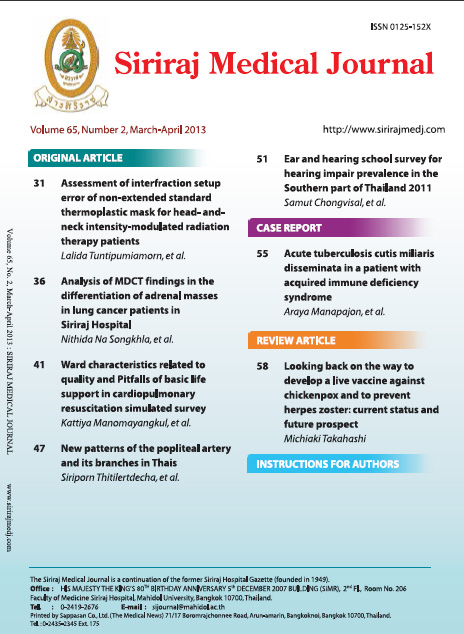Ward Characteristics Related to Quality and Pitfalls of Basic Life Support in Cardiopulmonary Resuscitation Simulated Survey
Abstract
Objective: To assess the quality of nurses’ basic life support (BLS) and to determine pitfalls in BLS in relation to ward
characteristics.
Setting: A 2,400-bed university hospital in Thailand.
Methods: A 1-year retrospective simulated audit for 2009 to assess nurses’ BLS performance at each step. Each observer assessed
the subjects’ performance by using a scoring sheet and noting the objective manikin data related to chest compression.
Results: A total of 57 wards from intensive care units, critical wards, procedural units, general wards or outpatient units were
audited. Only 24 out of 57 (42.1%) did airway maneuvers correctly, while only 2 out of 57 (3.5%) could rescue breathing
with chest movement. For the circulation maneuvers, carotid pulse check, hand position, the depth and the rate of cardiac
compression were mostly performed incorrectly. Exactly 14.0% of subjects did not palpate the carotid pulse, and 52.6%
palpated it incorrectly. Thirty-three nurses (57.9%) located and placed their hands on the wrong position. Forty-one nurses
(71.9%) did not achieve the requisite chest compression depth, while thirty-one nurses (54.4%) did not achieve the target
chest compression rate. The overall BLS performance of nurses in the High Risk Zone was better than that of nurses in the
Low Risk Zone, except in the case of the airway sector.
Conclusion: The CPR audit evaluated the resuscitation performance during simulated cardiac arrest in the service setting,
and compared wards nurses in 2 categories related to the risk of cardiac arrest. Improvement in the organisation of training
and the systematic approach to CPR should be adopted.
Downloads
Published
How to Cite
Issue
Section
License
Authors who publish with this journal agree to the following conditions:
Copyright Transfer
In submitting a manuscript, the authors acknowledge that the work will become the copyrighted property of Siriraj Medical Journal upon publication.
License
Articles are licensed under a Creative Commons Attribution-NonCommercial-NoDerivatives 4.0 International License (CC BY-NC-ND 4.0). This license allows for the sharing of the work for non-commercial purposes with proper attribution to the authors and the journal. However, it does not permit modifications or the creation of derivative works.
Sharing and Access
Authors are encouraged to share their article on their personal or institutional websites and through other non-commercial platforms. Doing so can increase readership and citations.











